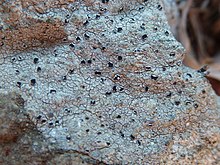| Trapeliaceae | |
|---|---|

| |
| Trapelia coarctata | |
| Scientific classification | |
| Domain: | Eukaryota |
| Kingdom: | Fungi |
| Division: | Ascomycota |
| Class: | Lecanoromycetes |
| Order: | Baeomycetales |
| Family: | Trapeliaceae M.Choisy ex Hertel (1970) |
| Type genus | |
| Trapelia M.Choisy (1929) | |
| Synonyms | |
| |
Trapeliaceae is a family of lichens in the order Baeomycetales. The family contains 12 genera and about 125 species.
Taxonomy
Trapeliaceae was originally circumscribed by French lichenologist Maurice Choisy in 1929. Hannes Hertel emended the family in 1970. Because of similarities in ascus structure, the family was originally classified in the Agyriineae, a suborder of the Lecanorales. Preliminary molecular phylogenetic studies showed that Agyriineae was not related to the Lecanorales, and the order Agyriales was resurrected to contain the family. Some authorities considered Trapeliaceae to be synonymous with Agyriaceae.
In 2007, Thorsten Lumbsch and colleagues transferred Trapeliaceae to the order Baeomycetales based on a sister relationship between Trapeliaceae and a clade in the Baeomycetales. This placement contradicted the results of some previous phylogenetic analyses that showed the Trapeliaceae as neither sister nor contained within the Baeomycetales. In 2011, Brendan Hodkinson and James Lendemer proposed the order Trapeliales to contain the family, as they considered the family to be part of "a clade that is molecularly and morphologically distinct from Baeomycetales". In 2018, the Lecanoromycetes was revised using a temporal approach that uses time-calibrated chronograms to define temporal bands for comparable ranks for orders and families. In this work, Trapeliales was synonymized with Baeomycetales. In a later review of the use of this method for biological classification, Robert Lücking considered this merge justified. This synonymy has been accepted in a recent review of fungal classification.
Genera
- Amylora Rambold (1994) – 1 sp.
- Aspiciliopsis (Müll.Arg.) M.Choisy (1929) – 2 spp.
- Coppinsia Lumbsch & Heibel (1998) – 1 sp.
- Ducatina Ertz & Søchting (2017) – 1 sp.
- Lignoscripta B.D.Ryan (2004) – 1 sp.
- Orceolina Hertel (1970) – 2 spp.
- Placopsis (Nyl.) Linds. (1866) – ca. 60 spp.
- Placynthiella Elenkin (1909) – 9 spp.
- Rimularia Nyl. (1868) – 4 spp.*
- Sarea Fr. (1825) – 2 spp.
- Trapelia M.Choisy (1929) – 24 spp.
- Trapeliopsis Hertel & Gotth.Schneid. (1980) – 20 spp.
References
- Resl, Philipp; Schneider, Kevin; Westberg, Martin; Printzen, Christian; Palice, Zdeněk; Thor, Göran; Fryday, Alan; Mayrhofer, Helmut; Spribille, Toby (2015). "Diagnostics for a troubled backbone: testing topological hypotheses of trapelioid lichenized fungi in a large-scale phylogeny of Ostropomycetidae (Lecanoromycetes)". Fungal Diversity. 73 (1): 239–258. doi:10.1007/s13225-015-0332-y. PMC 4746758. PMID 26321894.
- ^ Wijayawardene, Nalin; Hyde, Kevin; Al-Ani, LKT; Dolatabadi, S; Stadler, Marc; Haelewaters, Danny; et al. (2020). "Outline of Fungi and fungus-like taxa". Mycosphere. 11: 1060–1456. doi:10.5943/mycosphere/11/1/8. hdl:10481/61998.
- Hertel, H. (1970). "Trapeliaceae – eine neue Flechtenfamilie" [Trapeliaceae – a new lichen family]. Vorträge aus dem Gesamtgebiet der Botanik (in German). 4: 171–185.
- Cannon, Paul F.; Kirk, Paul M. (2007). Fungal Families of the World. CAB International. p. 454. ISBN 978-0851998275.
- Lumbsch, H. Thorsten; Schmitt, Imke; Lücking, Robert; Wiklund, Elisabeth; Wedin, Mats (2007). "The phylogenetic placement of Ostropales within Lecanoromycetes (Ascomycota) revisited". Mycological Research. 111 (3): 257–267. doi:10.1016/j.mycres.2007.01.006. PMID 17363237.
- Kauff, Frank; Lutzoni, François (2002). "Phylogeny of the Gyalectales and Ostropales (Ascomycota, Fungi): among and within order relationships based on nuclear ribosomal RNA small and large subunits". Molecular Phylogenetics and Evolution. 25 (1): 138–156. doi:10.1016/S1055-7903(02)00214-2. PMID 12383757.
- Miadlikowska, J.; Kauff, F.; Hofstetter, V.; Fraker, E.; Grube, M.; Hafellner, J.; et al. (2007). "New insights into classification and evolution of the Lecanoromycetes (Pezizomycotina, Ascomycota) from phylogenetic analyses of three ribosomal RNA- and two protein-coding genes". Mycologia. 98 (6): 1088–1103. doi:10.1080/15572536.2006.11832636. PMID 17486983.
- Hodkinson, Brendan P.; Lendemer, James C. (2011). "The orders of Ostropomycetidae (Lecanoromycetes, Ascomycota): Recognition of Sarrameanales and Trapeliales with a request to retain pertusariales over Agyriales" (PDF). Phytologia. 93 (3): 417–412.
- Kraichak, Ekaphan; Huang, Jen-Pan; Nelsen, Matthew; Leavitt, Steven D.; Lumbsch, H. Thorsten (2018). "A revised classification of orders and families in the two major subclasses of Lecanoromycetes (Ascomycota) based on a temporal approach". Botanical Journal of the Linnean Society. 188 (3): 233–249. doi:10.1093/botlinnean/boy060.
- Lücking, Robert (2019). "Stop the Abuse of Time! Strict Temporal Banding is not the Future of Rank-Based Classifications in Fungi (Including Lichens) and Other Organisms". Critical Reviews in Plant Sciences. 38 (3): 199–253. Bibcode:2019CRvPS..38..199L. doi:10.1080/07352689.2019.1650517.
- Rambold, G. (1994). "Amylora, a new genus in the Rimulariaceae". Bulletin de la Société Linnéenne de Provence. 45: 343–348.
- Lumbsch, H. Thorsten; Heibel, Esther (2007). "Coppinsia minutissima, a new genus and species in the Agyriaceae from the British Isles". The Lichenologist. 30 (2): 95–101. doi:10.1006/lich.1997.0120.